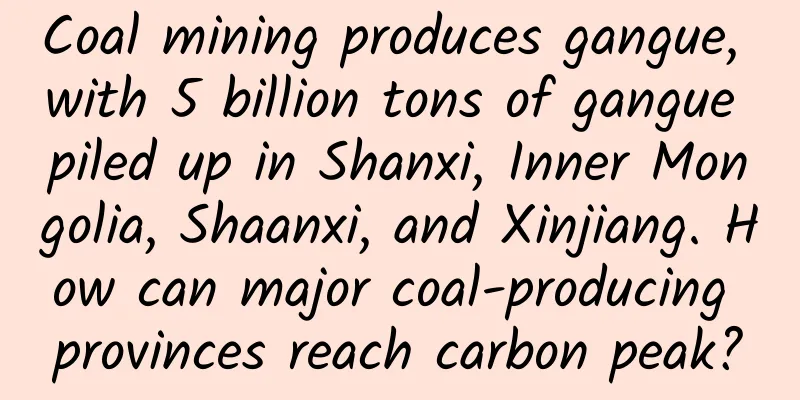Coal mining produces gangue, with 5 billion tons of gangue piled up in Shanxi, Inner Mongolia, Shaanxi, and Xinjiang. How can major coal-producing provinces reach carbon peak?

|
my country is a major coal mining country. According to statistics, there are more than 4,300 coal mines in my country with a coal production capacity of 4.71 billion tons in 2023. Among them, Shanxi and Inner Mongolia maintain a production of more than 1 billion tons, leading other provinces. Shaanxi, Xinjiang, Guizhou, Henan and other places also have a production capacity of more than 100 million tons. These seven provinces account for 87.7% of the country's raw coal production capacity. Data source: National Bureau of Statistics, China Coal Industry Association However, the process of coal mining and washing will produce a large amount of solid waste - coal gangue, which is a black-gray rock with a low carbon content and harder than coal that accompanies the coal seam during the coal formation process. It includes coal surrounding rock, interlayer stone, and gangue picked out by coal washing, accounting for 45%, 35% and 20% respectively. The amount of coal gangue emissions varies greatly depending on the coal seam conditions, mining conditions and washing processes. Generally, excavation gangue accounts for about 10% of the raw coal output, and coal selection gangue accounts for 12% to 18% of the raw coal output, accounting for an average of 15% to 20% of my country's total coal production, that is, 100 million tons of raw coal is produced each year and more than 15 million tons of gangue are discharged. According to China Environmental Report, my country will produce and discharge 735 million tons of coal gangue in 2021, 791 million tons in 2022, and 829 million tons in 2023, with a stockpile of more than 5 billion tons to date. But the question is, how should we deal with so much coal gangue? 1) Landfill and road construction Landfill and road construction are the simplest and most direct ways of utilization. Under the condition of appropriate particle size distribution, moisture content and compaction, the roadbed made of coal gangue has good strength, stability and bearing capacity, and can meet the requirements of relevant specifications. The Xingfen Expressway Xingtai to the Hebei-Shanxi border section was first built using coal gangue to build roads, which absorbed the 40-year-old gangue mountain on the south bank of the Qili River in Xingtai, covering an area of more than 400 acres and 120 meters high. Xingfen Expressway, source: Internet 2) Utilization of gangue brick building materials I don't know if you have any impression that in the 1990s, red brick factories were everywhere in rural areas, which used clay to make red bricks. But with the development of the times, clay has become a strategic resource, so clay bricks are also banned from production, and brick factories are abandoned. Instead, coal gangue, tailings and other sintered bricks and cement steam-cured bricks are used. Among them, coal gangue has a certain calorific value during the firing process, which can save fuel and reduce energy consumption, so it is called internal combustion bricks. Abandoned brick factory, source: Internet 3) Fuel Utilization Although gangue is not coal, it is a rock associated with coal and contains a certain amount of carbon components. When the carbon content in gangue exceeds 15%, it can release a high amount of heat after being crushed and burned, and can be used for power generation in power stations. Across the country, the installed capacity of power plants relying on gangue for power generation has reached more than 5 million kW, and the current annual processing capacity of gangue for power generation exceeds 50 million tons. 4) Underground filling The high hardness is a notable feature of coal gangue. It is a commonly used filling material for backfilling coal mine goafs. Of course, it can also be used as a component of land and arable land under certain proportions. According to relevant national regulations, coal gangue can also be directly backfilled underground. 5) Element extraction Some coal gangue and fly ash contain relatively rich rare elements such as lithium, gallium, germanium, mercury, nickel, selenium, etc., which can be used to extract valuable elements. Some mining areas have established coal gangue electrolytic aluminum plants and successfully refined metallic aluminum, but most of the research on other trace elements such as lithium, gallium, germanium, etc. is still in the laboratory stage, and the research focus is on the occurrence, enrichment, leaching and separation of trace elements. According to relevant reports, the current comprehensive utilization rate of coal gangue in my country is 73.6%. However, landfill and road casting account for 35%-45% of the total; coal gangue power plant combustion and other fuel utilization account for 10%-15%; gangue bricks and other building materials utilization account for 5%-10%; underground mining and filling account for 3%-7%; there are relatively few ways to extract elements, and the resource recovery rate is not high. Due to the resource characteristics of "rich in coal and less in oil" in my country, coal will continue to be the main energy source in my country for a long time. The continuous mining of coal will further generate more coal-based associated waste. How to make good use of these coal gangue is related to the realization of the coal industry's "carbon neutrality and carbon peak" goals. Please indicate the source of the reprint: "Hebei Key Laboratory of Science and Technology for the Utilization of Solid Waste into Building Materials" Main references: National Bureau of Statistics, China Statistical Yearbook 2023 China Coal Industry Association "2023 Coal Industry Development Annual Report" China Environment, "my country's coal gangue stockpile has exceeded 5 billion tons, how to deal with it?" Mei Lusen, Zhou Ruiqing, Ma Teng. Research on comprehensive utilization and resource application path of coal gangue[J]. Inner Mongolia Coal Economy, 2023, (23): 73-75. Zhang Shaohua, Wang Haodong. Current status and industrialization analysis of comprehensive utilization of coal gangue in my country[J]. Resource Conservation and Environmental Protection, 2024, (02): 24-27+46. Guo Fuqiang, Liu Kunlun, Yu Qiao, Yang Qinli, Su Peng. Discussion on comprehensive utilization of coal gangue[J]. Coal Processing and Comprehensive Utilization, 2023, (08): 89-93+98. |
<<: Pregnancy will make people stupid for three years. Anesthesia: I won’t take the blame for this!
>>: The “20-minute park effect” has become popular, but what do you do in the park?
Recommend
The number of followers increased by 20,000+ in 2 days, and the retention rate exceeded 90%. Only 5 things need to be done right for fission growth
In mid-April, we planned an online micro-class sh...
Halfway through 2021, have internet celebrity brands collectively “collapsed”?
The excitement in the new consumer track reached ...
Introduction to six recommended Android open source frameworks
1. Volley Project address: https://github.com/sma...
Zcool master Hou Shuai e-commerce main picture through train picture design tutorial
In e-commerce design, the main product image and ...
Three methods of event planning and promotion: gameplay, dissemination and fission!
Today, based on the basic planning capabilities, ...
Details are king! Let’s talk about the three key roles of scene design
If you ask me which app I've used recently ga...
Why is Panzhihua famous for mangoes? The dry and hot valley of the Jinsha River is a tropical fruit producing area in the subtropics
Although located in the subtropics, Panzhihua is ...
An inventory and analysis of mainstream promotion channels, teaching you how to spend 10 million promotion fees
People often ask, which promotion channel is more...
Some people devote their whole lives to the classification of small yellow flowers
Ever since the "father" of biological t...
Bengbu SEO training: seo optimization: how to improve website weight?
Step 1: Let us first understand the concept of we...
What is the official website of Douyin Blue V? Is it possible to change the name of Douyin’s business license?
The official website of Douyin Blue V is: https:/...
How can content grab the center position and attract attention? A guide to creating explosive content!
The so-called hot-selling content is content that...
Rare! A green sky appeared in this city!
Recently, the sky in Sioux Falls, South Dakota, U...
The terrifying bird inherited the "legacy" of the dinosaurs!
In today's South America, there lives a stran...
Who is the biggest foodie underground? The soil animal food web tells you
Produced by: Science Popularization China Author:...









